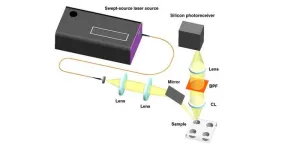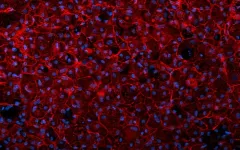(Press-News.org) In 1928, Indian physicist Sir C. V. Raman and his colleague K. S. Krishnan discovered that when light interacts with matter, parts of the scattered light undergo changes in energy due to interaction with molecular vibrations, resulting in what is known as Raman scattering. The discovery laid the foundation for Raman spectroscopy, a technique that takes advantage of these energy changes to create a unique fingerprint of the molecular structure of the material.
Currently, dispersive Raman spectroscopy is the go-to method for identifying samples in a variety of fields, such as material sciences, pharmaceuticals, environmental monitoring, and biomedicine. However, the spectrometers required to capture and detect the scattered light are bulky, limiting their use outside of laboratory settings. Additionally, most handheld Raman spectrometers have been developed only for chemical analysis.
In a study published in the Journal of Biomedical Optics, researchers from the Korea Advanced Institute of Science and Technology (Republic of Korea) and the Massachusetts Institute of Technology (MIT; United States) have developed a compact swept-source Raman (SS-Raman) spectroscopy system. The concept of SS-Raman was proposed in a previous patent (US9662047B2) but the implementation has not been done until recently due to the lack of narrow bandpass filters. This system is comparable to conventional dispersive Raman spectroscopy in its ability to identify both chemical and biological materials. The portable system addresses the limitations of current handheld spectrometers and opens doors for sample identification in biomedicine.
Conventional Raman spectroscopy systems use a fixed-wavelength light source, such as a laser, to excite the sample and induce Raman scattering. In contrast, SS-Raman spectroscopy uses a swept-source laser, which emits light over a continuous range of wavelengths. The excitation light is focused onto the sample after filtering through a short-pass filter which eliminates background noise. The scattered light is collected by a lens and filtered by a bandpass filter which isolates only the desired Raman-shifted wavelength range. The filtered light is then detected by the highly sensitive silicon photoreceiver which converts the optical signal into an electrical signal for sample analysis.
“The proposed SS-Raman setup uses a wavelength swept-source laser (822 to 842 nm), a narrow-bandwidth bandpass filter, and a highly sensitive point photoreceiver for acquiring Raman spectra. These components contribute to the development of compact and cost-effective Raman spectroscopy systems,” notes Dr. Jeon Woong Kang from MIT, one of the corresponding authors of the study.
To evaluate the effectiveness of the system, researchers compared Raman spectra from the new system with those obtained using traditional dispersive Raman spectroscopy for various chemical and biological samples. A diverse array of chemicals, such as phenylalanine, hydroxyapatite, glucose, and acetaminophen were considered as chemical samples for obtaining Raman spectra in the range of 900 to 1200 cm−1. For the biological sample, they scanned cross-sections of swine belly slices. The Raman spectra obtained from the proposed SS-Raman spectroscopy system closely resembled those obtained from traditional dispersive Raman spectroscopy with correlation coefficients ranging from 0.73 to 0.91, indicating its feasibility for identifying both types of samples.
Notably, in Raman spectroscopy systems, a significant expense comes from the need for high-quality filters and light sources. The SS system faced similar challenges, with background noise and the Raman spectra displaying broad peaks due to the bandpass filter.
To keep costs low, the researchers applied a signal processing method to the system. Gaussian filters were used to eliminate the ripple noise introduced by the unstable laser output. A deconvolution method was employed to sharpen the peaks in the Raman spectra and improve their resolution. Furthermore, polynomial background removal was utilized to eliminate the background noise arising from the low optical density of the filters.
Overall, the proposed system sets the stage for future developments in miniaturizing Raman spectroscopy for both chemical and biological analysis. However, there's still room for improvement, particularly in reducing the sample acquiring time, which currently takes over 40 seconds. To measure biological samples in less than a second, the researchers are developing a multichannel SS-Raman system equipped with multiple detectors and bandpass filters, which would hopefully enable the analysis of a wider range of molecules in the same amount of time for more diverse applications!
For details, see the Gold Open Access article by Jeonggeun Song, Peter T. So, Hongki Yoo, and Jeon Woong Kang, “Swept-source Raman spectroscopy of chemical and biological materials,” J. Biomed. Opt. 29(S2) S22703 (2024), doi 10.1117/1.JBO.29.S2.S22703
The article appears in the Special Issue Honoring Pioneer in Biomedical Optics Gabriel Popescu, edited by Randy A. Bartels, Stephen A. Boppart, and Kevin W. Eliceiri, in progress.
END
Portable swept-source Raman spectrometer for chemical and biomedical applications
The compact system can identify both chemical and biological materials while overcoming the limitations of bulky dispersive Raman spectrometers
2024-04-04
ELSE PRESS RELEASES FROM THIS DATE:
An hereditary liver disease cured with the help of gene scissors
2024-04-04
Argininosuccinate lyase deficiency (ASLD), also known as argininosuccinic aciduria, is a disease that has been enriched in the Finnish genetic heritage. In this severe metabolic disease, the body does not process proteins normally, instead resulting in a very dangerous accumulation of argininosuccinic acid and ammonia. Excess ammonia causes disturbances of consciousness, coma and even death.
In Finland, infants are screened for ASLD to determine the disease risk before symptoms develop. The treatment is an extremely ...
Dr. C. Barrett Bowling to be honored with the 2024 Thomas and Catherine Yoshikawa Outstanding Scientific Achievement in Clinical Investigation Award at #AGS24
2024-04-04
New York (April 4, 2024) — Today, the American Geriatrics Society (AGS) and the AGS Health in Aging Foundation (HiAF) announced that the 2024 Thomas and Catherine Yoshikawa Award for Outstanding Scientific Achievement in Clinical Investigation will be awarded to C. Barrett Bowling, MD, MSPH, Associate Professor in the Division of Geriatrics at Duke University School of Medicine.
The award will be presented at the AGS 2024 Virtual Annual Scientific Meeting (#AGS24), May 9-11 (pre-conference days May 7 & 8). At the conference, Dr. Bowling will deliver a lecture on “Geriatricizing” Chronic Disease Research: A Geriatrician’s ...
Finds at Schöningen show wood was crucial raw material 300,000 years ago
2024-04-04
During archaeological excavations in the Schöningen open-cast coal mine in 1994, the discovery of the oldest, remarkably well-preserved hunting weapons known to humanity caused an international sensation. Spears and a double-pointed throwing stick were found lying between animal bones about ten meters below the surface in deposits at a former lakeshore. In the years that followed, extensive excavations have gradually yielded numerous wooden objects from a layer dating from the end of a warm interglacial period 300,000 years ago. The findings suggested a hunting ground on the lakeshore. An interdisciplinary ...
Cells engineered to produce immune-boosting amino acids in prizewinning research
2024-04-04
Bacterial proteins often play a successful hide and seek game with the body’s immune system, making it difficult to combat the bacteria that cause diseases like staph infections.
Now, biomolecular engineer Aditya Kunjapur and colleagues have come up with a strategy to create bacteria that build and incorporate a key amino acid into their own proteins, which makes the proteins more “visible” to the immune system.
For this work toward building a better platform for possible future bacterial vaccines, Kunjapur is the winner of the 2024 BioInnovation Institute & Science Prize for Innovation. ...
Flexible fiber, coupled to the human body, enables chipless textile electronics
2024-04-04
A flexible electronic fiber that utilizes the human body as part of the circuit enables textile-based electronics without the need for batteries or chips, researchers report. According to the authors, the approach is well-suited for scalable manufacture of comfortable fiber-based electronics for a wide range of applications, including “smart” clothing. Textile electronic systems are designed to equip textile or fiber assemblies with electronic functions for sensing, computation, display, or communication. They create vast opportunities ranging from physiological monitoring to powering ...
Governance frameworks should address the prospect of AI systems that cannot be safely tested
2024-04-04
In this Policy Forum, Michael Cohen and colleagues highlight the unique risks presented by a particular class of artificial intelligence (AI) systems: reinforcement learning (RL) agents that plan more effectively than humans over long horizons. “Giving [such] an advanced AI system the objective to maximize its reward and, at some point, withholding reward from it, strongly incentivizes the AI system to take humans out of the loop,” write Cohen and colleagues. This incentive also arises for long-term planning agents (LTPAs) more generally, say the authors, and in ways empirical testing is unlikely to cover. It is thus critical to address extinction risk from these ...
Revealed: Mechanical damage during an asthma attack
2024-04-04
In asthma, the tightening of muscles around the bronchi causes damage to the airway by squeezing and destroying epithelial cells, which promotes the airway inflammation and mucus production often associated with an asthma attack, researchers report. The findings suggest that preventing the mechanical damage caused by an asthma attack, rather than treating only its downstream symptoms, could pave the way for therapies that stop the whole asthma inflammatory cycle. Asthma is a common airway disorder affecting more than 300 million people worldwide. Although it is primarily considered an inflammatory disease, a diagnostic feature of asthma is mechanical bronchoconstriction – the ...
Agricultural diversification yields joint environmental and social benefits
2024-04-04
Promoting livestock biodiversity and soil conservation strategies provides both social and environmental benefits, according to a new study. The findings suggest that well-designed polices aimed at incentivizing the adoption of multiple diversification strategies could mitigate simplified agriculture’s negative environmental, health, and social impacts. “Our interdisciplinary analysis spanning a wide array of regions provides convincing evidence that agricultural diversification is a promising win-win strategy for providing social and environmental benefits,” write the authors. Agricultural lands tend to be simplified ecosystems designed ...
Nerve cells not entirely “young at heart”
2024-04-04
After two decades in the United States, Martin Hetzer returned home to Austria in 2023 to become the 2nd President of the Institute of Science and Technology Austria (ISTA). A year into his new role, the molecular biologist remains engaged in the realm of aging research.
Hetzer is fascinated by the biological puzzles surrounding the aging processes in organs like the brain, heart, and pancreas. Most cells comprising these organs are not renewed throughout a human’s entire life span. Nerve cells (neurons) in the human brain, for instance, can be as old as the organism, even ...
Discovery of how limiting damage from an asthma attack could stop disease
2024-04-04
Scientists at King’s College London have discovered a new cause for asthma that sparks hope for treatment that could prevent the life-threatening disease.
Most current asthma treatments stem from the idea that it is an inflammatory disease. Yet, the life-threatening feature of asthma is the attack or the constriction of airways, making breathing difficult. The new study, published today in Science, shows for the first time that many features of an asthma attack—inflammation, mucus secretion, and damage to the airway barrier that ...
LAST 30 PRESS RELEASES:
Mercury exposure in northern communities linked to eating waterfowl
New Zealand researchers identify brain link to high blood pressure
New research confirms people with ME/CFS have a consistent faulty cellular structure
Hidden cancer risk behind fatty liver disease targets
Born in brightness, leading to darkness
Boron-containing Z-type and bilayer benzoxene
Hong Kong researchers break the single-field barrier with dual-field assisted diamond cutting
Work hard, play hard?
Wood becomes smart glass: Photo- and electro-chromic membrane switches tint in seconds
The Lancet: COVID-19 vaccine hesitancy decreased over time, though mistrust persists among certain groups, study of over 1 million people in England suggests
Psychosis patients ‘living in metaphor’ -- new study radically shifts ideas about delusions
Clinical trial in Ethiopia targets the trachoma scourge
Open-sourcing the future of food
Changes in genetic structure of yeast lead to disease-causing genomic instabilities
UC San Diego Health Sciences Grant Writing Course helps launch successful research careers
Study: Many head and neck cancer trials end early. Why?
Tufts vice provost for research named Foreign Fellow of Indian National Science Academy
New model improves prediction of prostate cancer death risk
Two wrongs make a right: how two damaging variants can restore health
Overlooked decline in grazing livestock brings risks and opportunities
Using rare sugars to address alcoholism
Research alert: New vulnerability identified in aggressive breast cancer
Ruth Harris honored with SSA Distinguished Service Award
Treasure trove of data on aging publicly accessible
Trees4Adapt project to address risks from climate change and biodiversity loss through tree-based solutions
Nature Communications study from the Lundquist Institute identifies molecular mechanism underlying peripartum cardiomyopathy
Pennington Biomedical’s Dr. Gang Hu appointed to NIH Reproductive, Perinatal and Pediatric Health Review Group
World-first project shows great promise to treat low eye pressure
New technique puts rendered fabric in the best light
Brain cancer digital twin predicts treatment outcomes
[Press-News.org] Portable swept-source Raman spectrometer for chemical and biomedical applicationsThe compact system can identify both chemical and biological materials while overcoming the limitations of bulky dispersive Raman spectrometers





